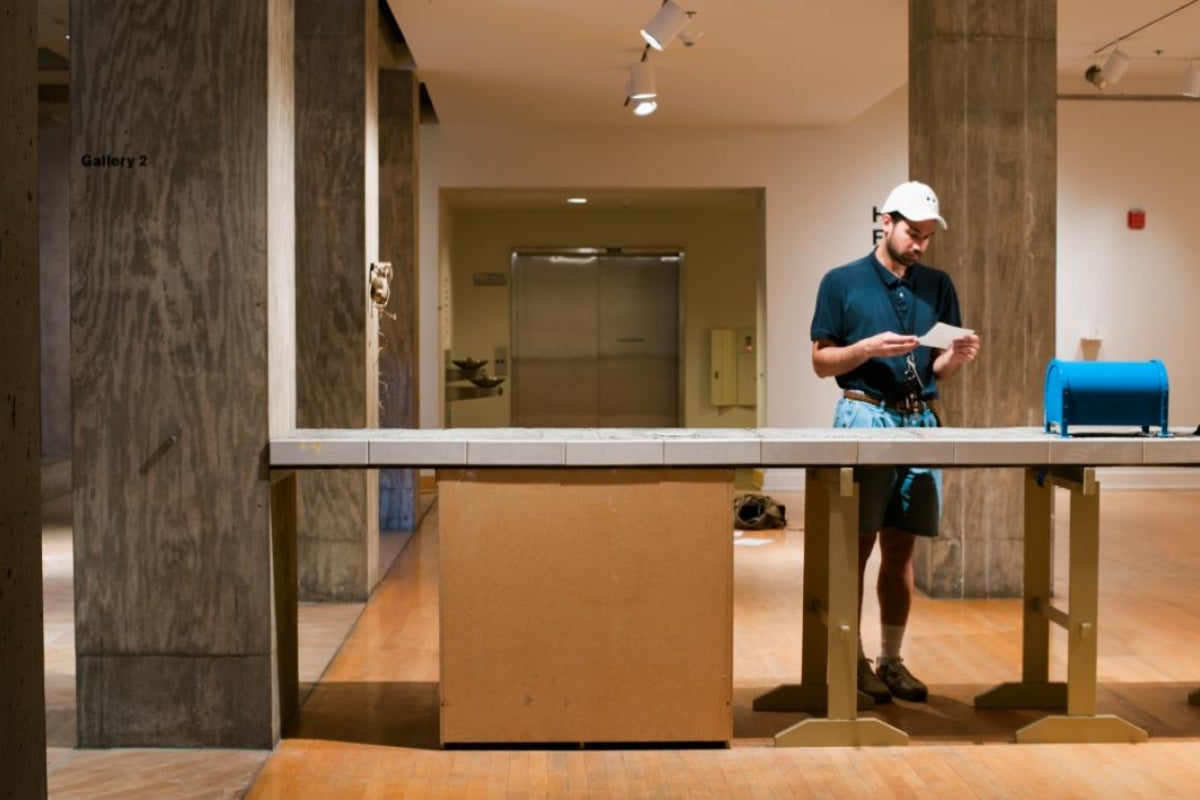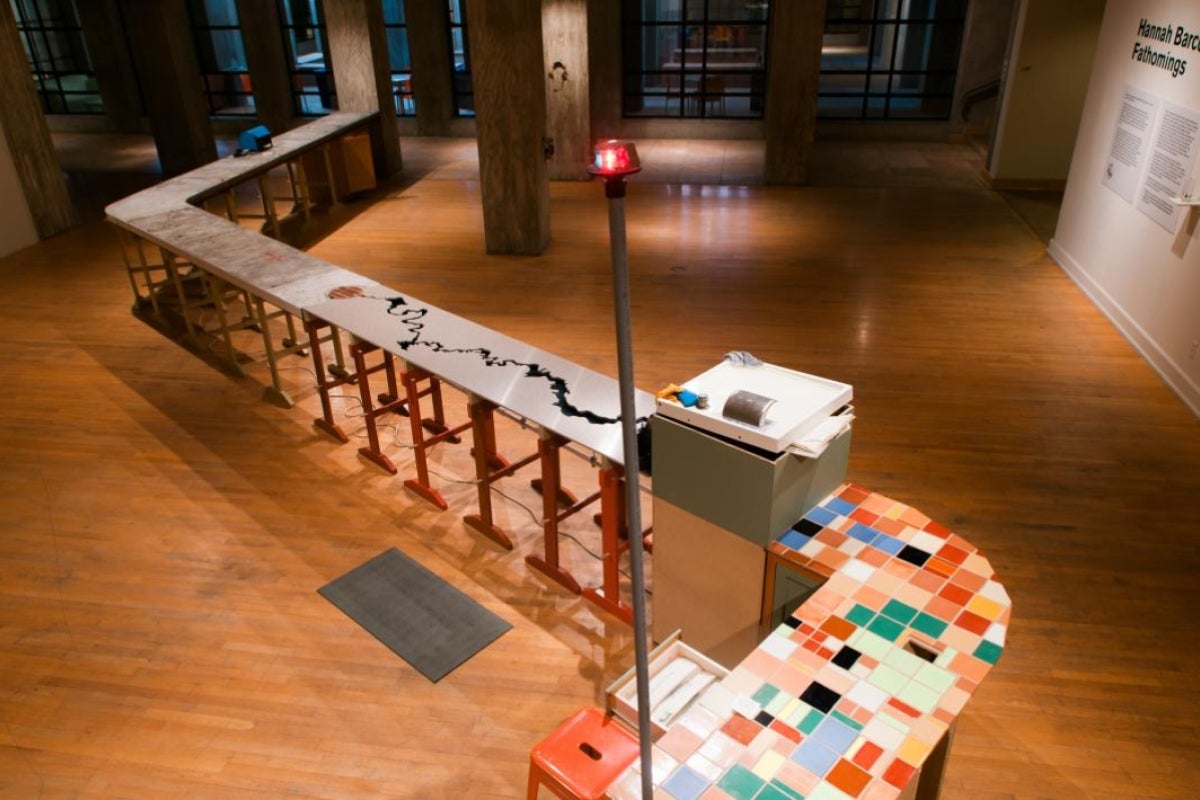Taking the museum out for a walk

ASU Art Museum visitors explore "Museum of Walking Annex," an exhibition at ASU Art Museum that is part of projectWALK. Photo by Lamp Left Media
In 1988, longtime collaborators and partners Marina Abramovic and Ulay began walking toward one another from opposite ends of the Great Wall of China. Ninety days later, the performance artists met in the middle and then went their separate ways, severing their relationship with a series of steps.
Like Abramovic and Ulay, visual artists of all disciplines have been incorporating walking into both performative and non-performative art practices since the 1960s, if not before.
“Walking is a defining human activity,” explained ASU Art Museum curator and interim director Heather Sealy Lineberry. “Walking can be practical, moving the body from place to place; ceremonial, such as religious and secular processions; spiritual, a pilgrimage or hike through a wilderness; social, a stroll with a friend in a park; or political, positioning the body in and through a contested zone.”
Museum of Walking
ASU School of Art Professor Angela Ellsworth co-founded the Museum of Walking (MoW) inside her office in ASU’s Tower Center Building in 2014 with fellow artist and ASU School of Art alumnus Steve Yazzie to explore the intersections between walking and art.
Ellsworth has said the initial idea for a museum of walking came from a conversation she had with curator Bruce Ferguson years ago. (Ferguson curated the exhibition "Walking and Thinking and Walking" at the Louisiana Museum in Denmark in 1996.) But both Ellsworth and Yazzie always hoped MoW would have the ability to move from place to place.
“MoW travels light,” said Ellsworth. “MoW is a somewhat itinerant museum. We are not a collecting institution, so we can relocate easily and quickly.”
This semester, MoW did move to a new location — ASU Art Museum Project Space in downtown Phoenix — where Ellsworth’s intermedia class mounted their own version of Ferguson’s 1996 exhibition.
The whole thing seems a bit clandestine, but it’s all part of a bigger initiative spearheaded by MoW and ASU Art Museum this semester called projectWALK, a city-wide series of events, exhibitions and walks that aim to address the larger role of walking within art, literature, culture, history and place.
projectWALK
“Heather Lineberry and I had been wanting to work together, and MoW and the subject of walking created an excellent foundation for our collaboration,” Ellsworth said. “Professor Ron Broglio in the ASU Department of English was also a key collaborator in projectWALK. Ron’s interest in walking and sustainability in addition to the literary history of walking was immensely helpful in our project.”
“The project is also a part of the museum’s Spotlight series, looking at innovative research projects by faculty members across disciplines in the Herberger Institute for Design and the Arts,” Sealy Lineberry said. “The Museum of Walking and its goals align with our mission to gather artists, students and the public to explore new art forms, often process-based and performative, which deeply connect with human experience and daily life.”
In total, there are currently four exhibitions at ASU Art Museum that fall under the larger projectWALK series, in addition to the Museum of Walking show at ASU Art Museum Project Space.
“Some of the artists in the projectWALK season we have been watching for a long time, like Francis Alÿs, and looking for an opportunity to introduce his work to our students and audiences,” Sealy Lineberry said. “He is one of the best-known artists utilizing walking in his art practice, usually in contested zones and fraught environments, to explore social and political realities. Some of the artists and works in the season are new to us, like Hannah Barco, a young artist from Chicago who creates engaging installations based on ideas and experiences of moving the body through urban space.”
At first glance, “Hannah Barco: Fathomings” looks like a giant kitchen counter installed in the museum gallery. Upon closer inspection, the counter is also a sidewalk.
“The ‘Fathomings’ installation uses formal shifts of scale to re-create in some sense this dynamic between individual and environment that I experience while walking,” Barco said. “The kitchen counter serves as a bit of a substitute for the physical act of walking as an embodied practice, because I believe the kitchen counter is very explicit and familiar in how it choreographs our bodies.
“As a disruption in the space, it perhaps helps us become aware of our bodies in the gallery as we are forced to walk around it and default into postures and gestures that we might usually only do at our kitchen counters at home, but are suddenly drawn out of us in the gallery by this object. I’ve tried to make a work that gets at the core vitalities and tensions of walking (for me), despite being manifested as a static physical installation in an underground gallery.”
‘Voices other than my own’
As part of her piece at the museum, Barco invited community members to be a part of creating the work. She spoke with ASU scholars, who also helped to complete the physical installation; Grady Gammage Jr. helped her tile the counter. But she also hosted a larger chewing-gum party, where ASU students and community members literally placed chewed gum on her “sidewalk.”
“This part of the project came from a very simple impulse to expand the perspective that is being represented within the installation and include voices other than my own in this exploration of the position of the individual in the greater world,” Barco said.
“Museum of Walking Annex,” another exhibition at ASU Art Museum that is part of projectWALK, takes a more historic look at walking, using pieces from the museum’s collection, ranging from an Andy Warhol photograph to a double-sided Reginald Marsh painting. But the idea of ASU community members contributing to the work remains.
Last week, there was a brand-new element introduced into the gallery: “One Small Step” is an electroacoustic piece composed by School of Music student Adele Etheridge Woodson in direct response to the artwork in the exhibition.
“I spent about an hour in the ‘Museum of Walking Annex’ just looking at each piece of art,” Etheridge Woodson said. “I didn't write anything down, I just sat and took it all in. I visited it again a week later, where I wrote down some common themes and ideas that jumped out at me.”
Now, visitors can scan a QR code to get a direct link to this new piece of music while they view the art in the gallery. Etheridge Woodson said she hopes the sound will add another layer of depth to the exhibition.
“The piece was intended to be listened to while in the gallery, so my hope is that the listener will be able to comprehend the themes not only visually but audibly,” Etheridge Woodson said. “It is as if the pieces of art and my music are playing a duet — they complement each other, playing differently, but still coming back to the same themes. And overall, creating a whole piece of work that I hope will inspire the listener, spark their curiosity and leave them thinking about the installation even after they leave the museum.”
‘Out into the world’
For the final act of “Hannah Barco: Fathomings,” the artist is returning to ASU Art Museum to physically dismantle the exhibition, and she’s asking the public to walk with her carrying pieces of the rubble.
“If the ‘Fathomings’ project was in its most basic sense a collection of different perspectives collected as a unified installation of materials, then the next step is to take those perspectives out into the world — and use my walking practice to further test them out,” Barco said.
Viewing artwork about walking is one thing, but Barco’s final performance, “Sounding Line: An Urban Walk,” will give visitors the chance to take part in a form of walking art themselves.
“I do feel connected to an amazing line up of walking artists, from the surrealists to the minimalists, from activists and street performers to the conceptual artists,” Barco said. “I’ve never affiliated myself with a particular brand of walking art, I’m always more interested in how a process that you engage through time, in this case walking, can have bundled into it all of these different histories. And as each step draws the body forward in repetition, there is the opportunity for the meanings to emerge — a stroll becomes a pilgrimage with glints of a parade, a picket line and a second line all embedded possibilities within the act of walking.”
Visit ASU Art Museum’s exhibitions page or events page for more information on projectWALK and its related programming. Hannah Barco’s “Sounding Line: An Urban Walk” will take place from 4 to 7 p.m. Saturday, April 15. Visitors are invited to meet at the ASU Art Museum to help physically carry pieces of the exhibition out of the gallery and into the world. Participants will depart for the walk at dusk and conclude by sunset.
More Health and medicine

Making medicine side-effect free
Many drugs that address medical conditions can come with serious side effects. In drug commercials, the litany of potential side…

Diagnostic research happening at ASU focused on detecting diseases earlier to save lives
It was one of America’s founding fathers, Benjamin Franklin, who may have foreshadowed today’s health care innovation when he…

Fighting the fungus among us
It starts with a spore.When inhaled, spores of the coccidioides fungus can cause coccidioidomycosis — better known as valley…





